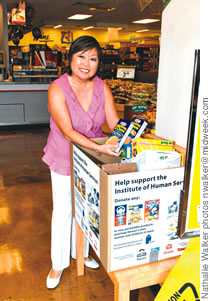The Easy Way to Help
Kraft’s Check-Out Hunger program makes it possible for shoppers to contribute to the Hawaii Foodbank at the checkout counter, helping to feed hungry folks during the holidays.

By .(JavaScript must be enabled to view this email address)
E-mail this story | Print this page | Archive | RSS |
 Del.icio.us
Del.icio.us
|
* KTA Super Stores on Big Island
Since its inception in 1994, the program has garnered more than $1.25 million in donations. Last year, CheckOut Hunger raised $184,940 for Hawaii’s hungry, the largest amount in the program’s 16-year history.
Kraft Foods in Hawaii kicks off the program with a $5,000 check, bringing its contribution to Check-Out Hunger to $35,000 over the past seven years.
“There are more than 183,500 individuals in Hawaii who benefit from the Hawaii Foodbank, its partners and special campaigns like Check-Out Hunger,” says Gerald Shintaku, customer business manager of Kraft Foods in Hawaii. “We encourage the community to help us spread the aloha spirit to those in need this holiday season.”
The campaign started Nov. 8 and runs through Jan. 10.
When asked if there is a goal for this year’s CheckOut Hunger program, Shintaku, also a Hawaii Foodbank director, indicates there is none.
“Year after year, even in the face of natural disasters and adversity, the people of Hawaii come through with generous hearts,” he says. “We always manage to exceed the level of giving of previous years.”
Hawaii Foodbank president Dick Grimm validates that point, stating, “Hawaii is a most giving state.”
That doesn’t mean the cornucopia of food donations is always filled. On our recent visit to Hawaii Foodbank’s warehouse, Grimm indicates there is sufficient inventory for only about 12 days. The customary year-end run on food stock is taking place, and a major replenishment is needed during the holiday period.
When the cupboard is bare, the food bank goes shopping, like everyone else. Its grocery list is enormous. Here’s where monetary donations are used.
Kenneth Ito, director of warehouse operations, works with Feeding America’s national agency and major food manufacturers and suppliers to purchase what’s needed.
He also manages the massive logistics of moving stock from out-of-state suppliers to Hawaii.
Last year, he brought in containers of rice, potatoes, apples, pears, carrots, tangerines, yams, assorted meats, cereals and canned goods.
The 23,668-square-foot warehouse in Mapunapuna is the heart of the Hawaii Foodbank operation. Here, huge trucks bring in inventory from various collection points to be inspected, sorted and stored. An average of 946,685 pounds of food is distributed from this busy operation each month. Astaff of 30-plus volunteers handle all of the tasks.
Working through a network of 250 community agencies, Hawaii Foodbank distributes more than 11 million pounds of food, including 2.6 million pounds of fresh produce annually, or nearly 9 million meals.
“Even though we increased our distribution of food by more than 1 million pounds a year in each of the last four years, 94 percent of all donations go to programs, not overhead,” says Grimm. “Hawaii Foodbank is one of the most efficient nonprofits in the state.”
That proficiency is validated by Charity Navigator, America’s largest charity evaluator, which gives Hawaii Foodbank a top four-star rating for financial and operational performance.
It seems incongruous in a land of plate lunches, lunch wagons and abundant regional and ethnic cuisines that food insecurity would be an issue. According to the new findings reported in “Hunger in America 2010,” more than 14 percent of Hawaii’s people are receiving emergency food assistance through the Hawaii Foodbank network.
This is an increase of 39 percent from just four years ago. Islanders receiving assistance annually include 55,050 children and more than 11,000 seniors. The report indicates 79 percent of client households served are food insecure, meaning they do not always know where they will find their next meal.
Many of the client households served by Hawaii Foodbank report that their household incomes are inadequate to cover basic household expenses. Tough choices are made each month, deciding among paying for utilities, rent/mortgage, medical bills, transportation or food.
So, this Thanksgiving, as you gather loved ones around the dinner table and express gratitude for the season’s bounty, know that your donation to community charity enabled someone less fortunate to have an extra scoop of human kindness.
Happy Thanksgiving.
Page 2 of 2 pages for this story < 1 2
E-mail this story | Print this page | Comments (0) | Archive | RSS
Most Recent Comment(s):








